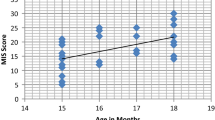Abstract
This study examined the relationship between sensorimotor functioning and communicative intent in children with autism. Ten children with autism, four verbal and six nonverbal, served as subjects. Sensorimotor functioning was assessed on object permanence, means- end, causality, vocal and gestural imitation, the construction of objects in space and schemes for relating objects. A 2-hr communication sample was also obtained and analyzed for the number and diversity of pragmatic functions expressed. Object permanence was not significantly related to either the diversity or total number of pragmatic functions. Means-end was significantly related to both of these measures, while vocal imitation was significantly related to the total number of pragmatic functions expressed. In addition, means-end was significantly correlated with performance on the vocal and gestural imitation scales.
Similar content being viewed by others
References
Bates, E. (1976).Language and context. New York: Academic Press.
Bates, E., Benigni, L., Bretherton, I., Camaioni, L., & Volterra, V. (1979).The emergence of symbols: Cognition and communication in infancy. New York: Academic Press.
Bloom, L. (1970).Language development: Form and function in emerging grammars. Cambridge: MIT Press.
Bloom, L. (1973).One word at a time. The Hague, Netherlands: Mouton.
Bloom, L. Language development. (1975). In F. Horowitz (Ed.),Review of child development research (pp. 245–303). Chicago: University of Chicago Press.
Bowerman, M. F. (1974). Discussion summary: Development of concepts underlying language. In R. L. Schiefelbusch & L. L. Lloyd (Eds.),Language perspectives: Acquisition, retardation and intervention (pp. 191–209). Baltimore: University Park Press.
Cantwell, D., & Baker, L. (1987).Developmental speech and language disorders. New York: Guilford.
Corrigan, R. (1978). Language development as related to stage 6 object permanence development.Journal of Child Language, 5, 173–196.
Cromer, R. (1976). The cognitive hypothesis of language acquisition and implications for child language deficiency. In D. Morehead & A. Morehead (Eds.),Normal and deficient child language (pp. 283–333). Baltimore: University Park Press.
Curcio, F. (1978). Sensorimotor functioning and communication in mute autistic children.Journal of Autism and Childhood Schizophrenia, 8, 281–292.
DeMeyer, M. K., Alpern, G. D., Barton, S., Demeyer, W. E., Churchill, D. W., Hingtgen, J. N., Bryson, C. Q., Pontius, W., & Kimberlin, C. (1972). Imitation in autistic, early schizophrenic, and non-psychotic subnormal children.Journal of Autism and Childhood Schizophrenia, 2, 264–287.
Dunst, C. J. (1980).A clinical and educational manual for use with the Uzgiris and Hunt scales of infant psychological development. Baltimore: University Park Press.
Freeman, B. J., & Ritvo, E. R., (1976). Cognitive assessment. In E. R. Ritvo (Ed.),Autism: Diagnosis, current research, and management (pp. 27–35). New York: Spectrum.
Koegel, R. L., Rincover, A., & Egel, A. L. (1982).Educating and understanding autistic children. San Diego: College-Hill.
Leonard, L. B. (1978). Cognitive factors in early linguistic development. In R. L. Schiefelbusch (Ed.),Bases of language intervention (pp. 67–96). Baltimore: University Park Press.
Lovaas, O. I. (1987). Behavioral treatment and normal educational and intellectual functioning in young autistic children.Journal of Consulting and Clinical Psychology, 55, 3–9.
MacNamara, J. (1972) The cognitive basis of language learning in infants.Psychological Review, 79, 1–13.
Olson, D. R. (1970). Language and thought: Aspects of a cognitive theory of semantics.Psychological Review, 77, 257–273.
Prizant, B. M., & Duchan, J. (1981). The functions of immediate echolalia in autistic children.Jouranl of Speech and Hearing Disorders, 46, 241–249.
Prizant, B. M., & Rydell, P. (1981, November)A functional analysis of delayed echolalia of autistic children. Paper presented at the annual convention of the American Speech-Language-Hearing Association, Los Angeles.
Schopler, E., Lansing, E., & Waters, L. (Eds.). (1983).Teaching activities for autistic children. Baltimore: University Park Press.
Schopler, E., Reichle, R. J., & Lansing, M. (1980).Individualized assessment and treatment for autistic and developmentally disabled children: Volume 2. Teaching stategies for parents and professionals. Baltimore: University Park Press.
Serifica, F. C. (1971). Object concept in deviant children.American Journal of Orthopsychiatry, 41, 473–482.
Sigman, M., & Ungerer, J. (1981). Sensorimotor skills and language comprehension in autistic children.Journal of Abnormal Child Psychology, 9, 149–165.
Slobin, D. I. (1973). Cognitive prerequisites for the development of grammar. In D. I. Slobin & C. Ferguson (Eds.),Studies of child language development. New York: Holt, Rinehart & Winston.
Uzgiris, I. C., & Hunt, J. McV. (1975).Assessment in infancy. Chicago: University of Illinois Press.
Watson, L. R., Lord, C. Schaffer, B., & Schopler, E. (1989).Teaching spontaneous communication to autistic and developmentally handicapped children. New York: Irvington.
Wetherby, A. M. (1986). Ontogeny of communicative functions in autism.Journal of Autism and Developmental Disorders, 16, 295–316.
Wetherby, A. M., & Gaines, B. (1982). Cognition and language development in autism.Journal of Speech and Hearing Disorders, 47, 63–70.
Wetherby, A. M., & Prutting, C. A. (1984). Profiles of communicative and cognitive-social abilities in autistic children.Journal of Speech and Hearing Research, 27, 364–377.
Author information
Authors and Affiliations
Rights and permissions
About this article
Cite this article
Abrahamsen, E.P., Mitchell, J.R. Communication and sensorimotor functioning in children with autism. J Autism Dev Disord 20, 75–85 (1990). https://doi.org/10.1007/BF02206858
Issue Date:
DOI: https://doi.org/10.1007/BF02206858




